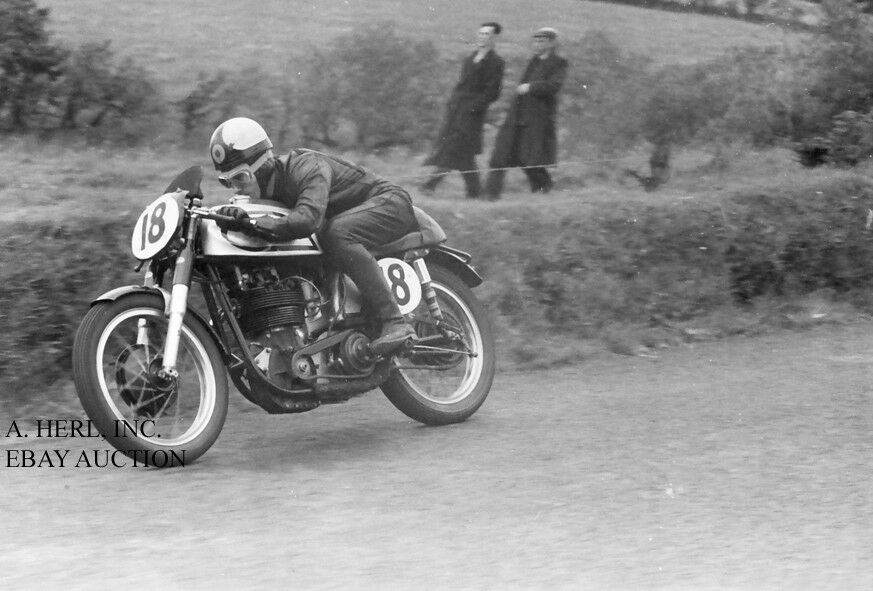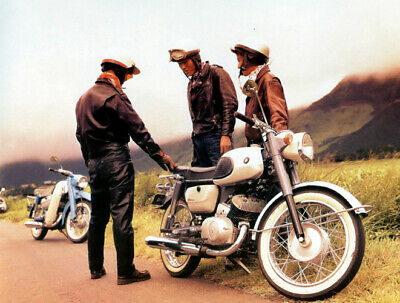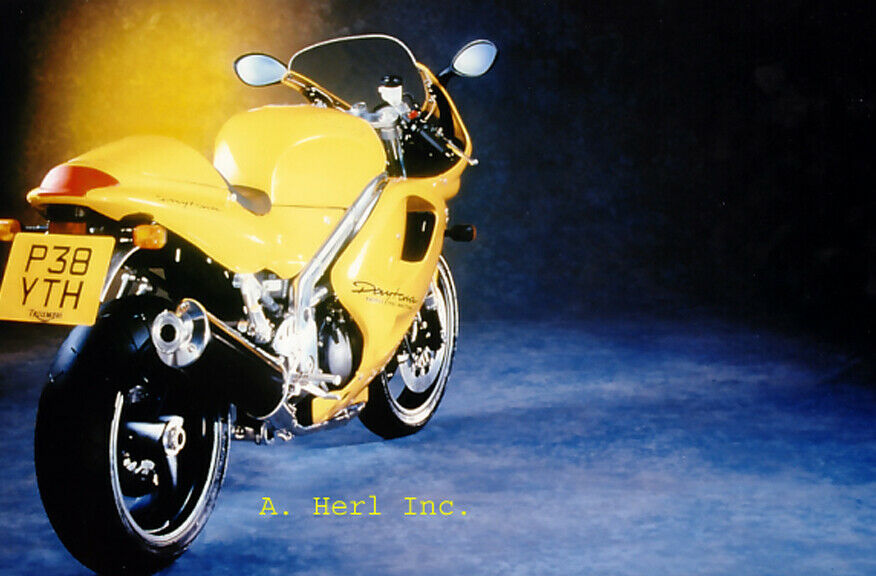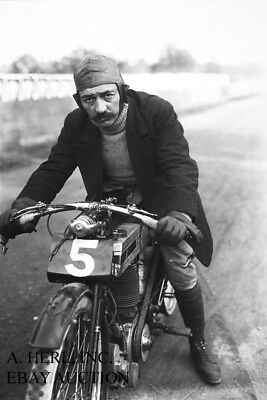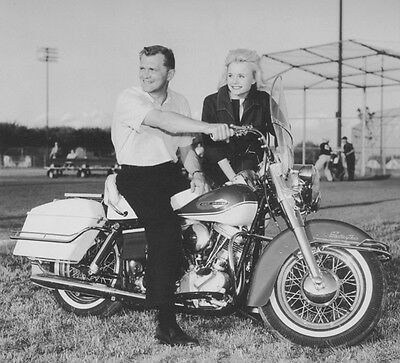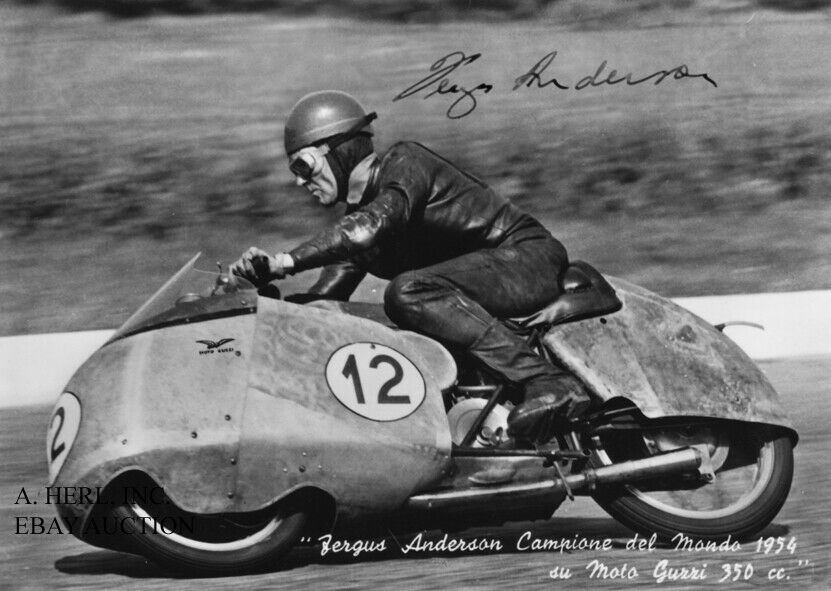-40%
Harley-Davidson Panhead engine drawing 1948 factory press motorcycle photograph
$ 5.14
- Description
- Size Guide
Description
A superb and rare photo of the1948 Harley-Davidson Panhead engine design.
The
Harley-Davidson Panhead
motorcycle engine was nicknamed like that because of the distinct shape of the valve-rocker covers. The engine is a two-cylinder, two-valve-per-cylinder, pushrod V-twin. The engine replaced the Knucklehead engine in 1948 and was manufactured until 1965 when it was replaced by the shovelhead. As the design of Harley-Davidson engines has evolved through the years, the distinctive shape of the valve covers has allowed Harley enthusiasts to classify an engine simply by looking at the shape of the covers, and the Panhead has covers resembling an upside-down pan. The "Captain
America
" chopper used by Peter Fonda in the movie Easy Rider (1969) had a Panhead engine, as well as the bike ridden by Dennis Hopper's character. Currently, a number of third-party engine manufacturers produce custom Panhead-style engines in a variety of bores, many much larger than the original-design displacements. Each manufacturer includes significant subtle upgrades to the original design to drastically improve the performance and reliability while still providing the original styling and overall engine structure.
Harley-Davidson
has a long and very interesting history that started as early as in 1901. That year, William S. Harley, age 21, drew up plans for a small engine with a displacement of 7.07 cubic inches (116 cc) and four-inch (
102 mm
) flywheels. The engine was designed for use in a regular pedal-bicycle frame. Over the next two years Harley and his childhood friend Arthur Davidson labored on their motor-bicycle using the northside
Milwaukee
machine shop at the home of their friend, Henry Melk. It was finished in 1903 with the help of Arthur's brother, Walter Davidson. Upon completion the boys found their power-cycle unable to conquer
Milwaukee
's modest hills without pedal assistance. Will Harley and the Davidsons quickly wrote off their first motor-bicycle as a valuable learning experiment. Work immediately began on a new and improved second-generation machine. This first "real" Harley-Davidson motorcycle had a bigger engine of 24.74 cubic inches (405 cc) with 9.75 inches (
25 cm
) flywheels weighing
28 lb
(
13 kg
). The machine's advanced loop-frame pattern was similar to the 1903 Milwaukee Merkel motorcycle (designed by Joseph Merkel, later of Flying Merkel fame). The bigger engine and loop-frame design took it out of the motorized-bicycle category and would help define what a modern motorcycle should contain in the years to come. The boys also received help with their bigger engine from outboard motor pioneer Ole Evinrude, who was then building gas engines of his own design for automotive use on
Milwaukee
's
Lake Street
. The prototype of the new loop-frame Harley-Davidson was assembled in a 10 ft × 15 ft (3.0 m × 4.6 m) shed in the Davidson family backyard. Most of the major parts, however, were made elsewhere, including some probably fabricated at the
West Milwaukee
railshops where oldest brother William A. Davidson was then toolroom foreman. This prototype machine was functional by
September 8, 1904
, when it competed in a
Milwaukee
motorcycle race held at
State
Fair
Park
. It was ridden by Edward Hildebrand and placed fourth. This is the first documented appearance of a Harley-Davidson motorcycle in the historical record. In January 1905, small advertisements were placed in the "Automobile and Cycle Trade Journal" that offered bare Harley-Davidson engines to the do-it-yourself trade. By April, complete motorcycles were in production on a very limited basis. That year the first Harley-Davidson dealer, Carl H. Lang of
Chicago
, sold three bikes from the dozen or so built in the Davidson backyard shed. (Some years later the original shed was taken to the Juneau Avenue factory where it would stand for many decades as a tribute to the Motor Company's humble origins.
This is a very nice and very rare
non period
photo that reflects a wonderful era of Harley ‘s motorcycle history in a wonderful way. This is your rare chance to own this photo, therefore it is printed in a nice large format of ca. 8" x 10" (ca. 20 x 26 cm). It makes it perfectly suitable for framing!
Shipping costs will only be $ 7.00 regardless of how many photos you buy. For 5 or more photos, shipping is free!
(Note: A. Herl, Inc. does not appear on photo, for ebay purposes only)
No copyright expressed or implied. Sold as collectable item only. We are clearing out our archives that we have gathered from various sources.
All items always sent well protected in PVC clear files
and board backed envelopes.
We have photographs that came from professional collections and/or were bought from the original photographer or press studio! They are all of professional and excellent quality.
After many decades of professionally collecting photographs and posters we are clearing out our archives. They make the perfect gift and are perfectly suited for framing. They will look gorgeous unframed and will be a true asset nicely framed with a border. They are a gorgeous and great asset in every home, workshop, workplace, restaurant, bar or club!
First come - first served. And you can always contact us for your requests. Please ask any questions before the auction ends.

